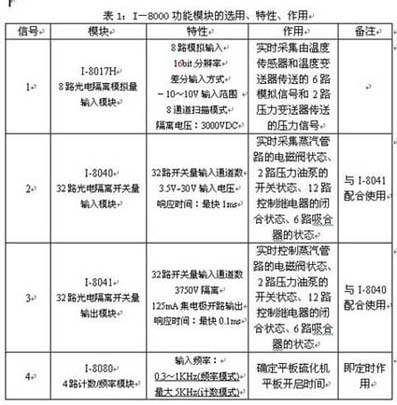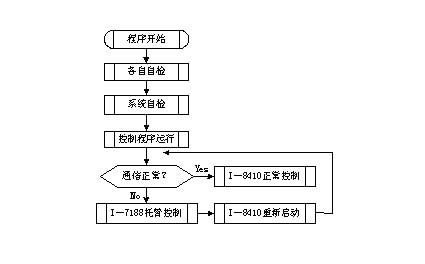Design of Monitoring System for Distributed Flat Vulcanizing Unit Based on ICP I-7188EAD/8410
2018-10-05 19:01:46
| 1 Development needs and background Rubber and plastic products are becoming more and more popular in China's industry, especially oil-resistant rubber and plastic products, which are more popular. Hubei Jiade Rubber & Plastic Products Co., Ltd. is specialized in producing submersible pumps, oilfield pumps, oil pipelines, etc. Professional rubber and plastic products manufacturers, because rubber vulcanization needs to be vulcanized under a certain time, temperature and pressure, the traditional vulcanization control method is determined by the driver's experience, there are many drawbacks, resulting in rubber under sulfur, sulfur, Greatly affected the quality of rubber and plastic products. In 2002, we integrated a set of distributed rubber for the company using the ICP DAS I-7188 and embedded controlled I-8410 and I-7000 remote control module. The monitoring system of the plastic vulcanizing machine integrates the control information and production information into the company's MIS management system, which is beneficial to the company's planning and analysis and has achieved good economic benefits. The system design is now outlined as follows. 2 system architecture and composition 2.1 program selection  Figure 1: Scheme selection diagram Among the three control schemes shown in Figure 1, although the first scheme is simple in structure, once the I-8421 is down, the flat vulcanizer will not operate normally. At the same time, because many control parameters are stored on the host computer, no doubt The burden on the host computer is increased, and its security and reliability are relatively poor. In the second scheme, although some of the control is undertaken by the embedded network controller I-7188EAD, the I-87K4 has no control function, and there are also hidden dangers of poor reliability and security. In the third scheme, important control parameters are stored on the host computer. The I-7188EAD plays a dual role. The local control of the flat vulcanizer is completed by I-8410. The I-7188EAD is the main controller in the system, and the I-8410 is The controlled device satisfies the master-slave requirements of the RS-485 communication protocol. Once the process parameters need to be changed, the I-7188EAD communicates with the host computer to obtain data. In order to improve the reliability of the system, the I-7000 module is added to the system. Once the communication signal of the I-8410 disappears or a fault occurs, the control function is controlled by I. -7188EAD is hosted and executed by I-7000 (multiplexed), but the control function is relatively simple at this time, only temperature and pressure detection, vulcanization timing, manual open tablet client, no system equipment fault monitoring, temperature PID In the third scheme, the two-level controller realizes the dual-machine redundancy, and the local control also has two sets at the same time, but the control function of one set is relatively complete, and the control function of the standby set is relatively simple. The control of the flat vulcanizing machine can be realized, thereby realizing the functions of controller redundancy and actuator standby/multiplexing, meeting the requirements of modern process control [1], greatly improving the safety and reliability of the system and satisfying the requirements. Users' requirements of "high reliability, high safety, high technology, high efficiency". 2.2 System working principle When the third scheme is adopted, the whole process is: firstly, the system is turned on, the server, I-7188EAD, I-8410 and I-7000 all perform a handshake signal detection, check whether the communication of the system is normal, due to different When the rubber and plastic products are vulcanized, the process parameters are different. The process control server sends the workpiece number to the I-7188EAD, and the temperature, pressure, and time are lowered to the I-7188EAD to control the I-7000. The I-7188EAD also gives I The -8410 transmits the above information in case the I-8410 performs process control in accordance with the instructions of the server. During the control process, the I-7188EAD and I-8410 always pass the “heartbeat†information to each other. Once the I-7188EAD sends 10 heartbeat messages and still cannot receive the control information transmitted by I-8410, the I-7188EAD judges the I-8410 communication. Failure, send a digital signal, and host the control system, so that the I-7000 starts to work, and will send a control signal to disconnect the I-8410's power. After 1 minute, the control signal is sent again, and the I-8410 is powered back on. , resume normal operation. After the communication resumes normal, the I-7000 exits the control. In addition to its standby execution control function, the I-7000 also undertakes 10 solenoid valves, 12 circuit breakers, and 12-way suction devices in the steam pipeline. Real-time control and monitoring, therefore, the system has dual functions for any controller, saving equipment costs, and greatly playing the role of each controller to meet the design requirements. The architecture diagram of the distributed flat vulcanizing unit control system is shown in Figure 2.  Figure 2: Architecture diagram of the control system of the distributed flat vulcanizing unit I-7188EAD communicates with I-8410 and I-7000 using RS-485, and the baud rate is set to 19200bps. Among them, I-7188EAD is the main controller of the local control unit, I-7000 and I-8410 are controlled. Device. The I-7188EAD and the control server use TCP/IP communication. 2.3 System Configuration 2.3.1 I-7188EAD I-7188EAD is a PC-enabled embedded network controller, also known as network protocol converter, it has 512KB FLASH, 512KB SRAM, 2KB EEPROM, 31B NVSRAM, built-in real-time clock, watchdog timer, built-in MiniOS7 Operating system, 64-bit hardware unique serial number, support for user program encryption, 10BASE-T network controller compatible with NE-2000, support for TCP/IP protocol. It has a unique dual watchdog security design, which consists of a software watchdog and a hardware watchdog. In case the master computer is down, all the output modules enter the preset security state, which meets the industrial security requirements. Convenient, which can greatly increase system security. 2.3.2 I-8410 Configuration I-8410 is a PC-Based embedded controller (controlled) that can extend 4 parallel control I/O modules, with 256KB Flash ROM and 128KB SRAM, 2KB EEPROM, built-in look The dogdog timer is conducive to safe and reliable operation of the system, and has built-in dedicated MiniOS7 operating system. It is suitable for writing control programs with TC. It has 3 COM ports, of which COM2 is RS-485 communication port. It also has a unique dual watchdog security design that instantly reboots when the program is down, and has a software watchdog interlock with each I/O module, greatly improving system security. The modules used and their characteristics and effects are shown in Table 1.  Table 1: Selection, characteristics, and functions of the I-8000 function module 2.3.2 I-7000 module selection The main modules are: I-7011PD programmable thermocouple input module with display, I-7012F fast analog input module, I-7041 isolated switch input module, I-7042 isolated OC gate The output module and the I-7080 frequency/counting input module have the same functions as the similar modules selected by the I-8410, and are not described here. 3 Software Design 3.1 Communication between I-7188EAD and I-8410 Since both I-7188EAD and I-8410 have control functions, the two must cooperate with each other to coordinate the operation to improve the reliability of the system. Therefore, the system The key to software design is the communication procedure between the I-7188EAD and the I-8410. It is necessary to define the communication method, protocol, etc. between the two. Since the I-7188EAD and I-8410 each have RAM, ROM and EEPROM, which facilitates system programming and storage of certain data, the heartbeat signal of the communication is I during programming. The /O signal transmits only the necessary control information to each other and stores it. Under the MiniOS7 operating system, using TC2.0 and their respective library functions. The flow chart is shown in Figure 3.  Figure 3: Communication between I-7188EAD and I-8410 3.2 I-8410 control program I-8410 control program is relatively simple, because the grid provides a large number of library functions for the corresponding module control, can be directly used when writing with TC2.0, giving users great convenience. Mainly divided into: module initialization, data acquisition and control, data analysis, system fault diagnosis and prompts (output to external indicators through the DO signal), data communication. 3.3 Process Control Server Program In the process of control program design, the process control server mainly communicates with I-7188EAD. We use the OPC server and ActiveX control provided by ICP DAS, and adopt the configuration king configuration software, which is very convenient. The programming process of the host computer. The Windows 2000 operating system and Microsoft SQL 6.5 are installed on the server, which facilitates the storage of control information in the enterprise management MIS system, which is beneficial to production management personnel planning and statistics. This program mainly includes man-machine interface design, database access mode design, IE release and browsing design, system fault diagnosis design, system configuration design, database design and security design (firewall design), report design, file system. Management design, file output management design (report output, printing, management). 4 Application experience and experience Because the I-7188 embedded network controller and I-8000 embedded control module have unique dual watchdog security design, and each software I/O module has a software watchdog Interlocking, and a dedicated and stable MiniOS7 operating system, greatly improve the security and reliability of the system operation, while the system uses controller redundancy, control actuator reuse, saving investment costs, and improving enterprise and system developers. Economic benefits. The system has been in operation for more than a year and has been operating stably. The quality of rubber and plastic products produced has been improved, and the defective rate and reject rate have been greatly reduced. The production efficiency has been improved and the labor intensity has been reduced. In short, ICP DAS products enable system integrators and system users to achieve good economic benefits. |
references:
[1]. RS-485 datasheet http://
[2]. COM datasheet http://
:
0 times
Window._bd_share_config = { "common": { "bdSnsKey": {}, "bdText": "", "bdMini": "2", "bdMiniList": false, "bdPic": "", "bdStyle": " 0", "bdSize": "24" }, "share": {}, "image": { "viewList": ["qzone", "tsina", "tqq", "renren", "weixin"], "viewText": "Share to:", "viewSize": "16" }, "selectShare": { "bdContainerClass": null, "bdSelectMiniList": ["qzone", "tsina", "tqq", "renren" , "weixin"] } }; with (document) 0[(getElementsByTagName('head')[0] || body).appendChild(createElement('script')).src = 'http://bdimg.share. Baidu.com/static/api/js/share.js?v=89860593.js?cdnversion=' + ~(-new Date() / 36e5)];
7020 Aluminium Alloy,Extruded Tube,Rectangular Pipe
Yinggui Metal Product Co., Ltd. , http://www.shaluminumplate.com